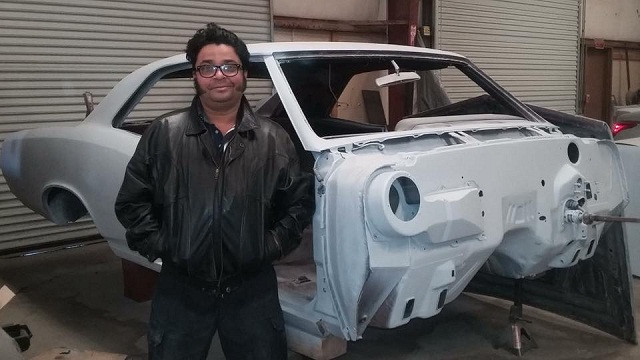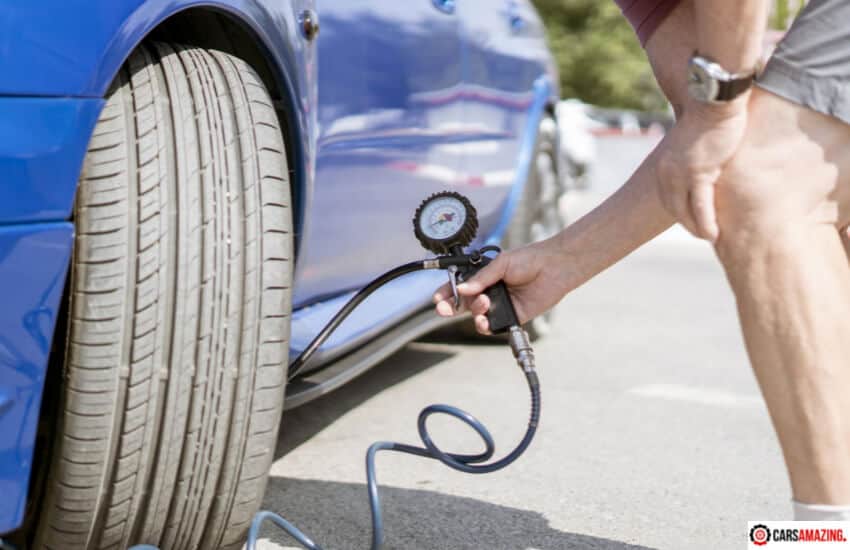Last Updated on February 1, 2023 by Leepu Da Maxim
From RepairPal.com, it costs between $223 and $237 to replace the tire pressure sensor. The labor cost range is $53 – $67, and you’ll pay $170 for the parts. Note that the costs are exclusive of taxes and fees. Also, they are not specific to your vehicle and location. It means that the price can go up or down, and the given range is an average.
Key Takeaways
- You should keep in mind that the exact cost of changing a tire pressure sensor depends on the make and model of the vehicle, the type of sensor, the repair location, etc.
- TPMS sensors have a lifespan of 5-10 years and you should immediately change the sensor when it will stop working properly
- If the sensor is damaged or provides incorrect reading then you should change the tire pressure sensor with a new one
- if you change the tire or rotate the tire then you should also change the tire pressure sensor
From YourMechanic.com, here’s a table showing TPMS replacement costs for some types of cars:
| Car Type | Model Year | Cost of Parts | Labor Cost | Full Estimate |
| Porsche Macan | 2016 | 115 | 80 | 195 |
| Audi A6 Quattro | 2013 | 115 | 80 | 195 |
| Cadillac XTS | 2016 | 104 | 80 | 184 |
| Dodge Ram 2500 | 2010 | 5 | 80 | 85 |
The TPMS As An Important Part Of Your Car
The TPMS or tire pressure sensor is an integral part of your vehicle. On the dashboard, the TPMS system has this icon:
The sensor helps the car’s computer to detect tire-related problems. For example, if you puncture the tire, the TPMS sensor will light up. It is because the puncture deflated the tire, and now, it needs attention.
But there’s more.
If your right front tire is underinflated, you’ll see this icon:
Since you’ve warmed up to the topic, here’s what this article features:
1. Do TPMS sensors need to be replaced?
2. How long will it take to replace a tire pressure sensor?
3. Can I drive with a bad TPMS sensor?
4. How do I know if my tire pressure sensor is bad?
5. Can I replace my tire pressure sensor?
6. How do I fix a pressure sensor without replacing it (resetting)?
7. How long can you drive after the tire pressure light comes on?
Let’s go!
Do TPMS (Tire Pressure) Sensors Need To Be Replaced?
Yes, they do.
All TPMS sensors use a battery to operate. To save battery power, they don’t work 24/7 and always run on energy-saving mode. But does the battery have a lifespan? Yes.
Your TPMS sensor battery can live for up to 10 years. After that, you’ll need to replace it. Sometimes, you may need to change the entire tire pressure monitoring system.
How Long Will It Take To Replace A Tire Pressure Sensor?
A faulty tire sensor takes you between 30 and 40 min to replace. If you include the safety inspection, the total time will be an hour.
Can I Drive With A Bad TPMS Sensor?
A bad TPMS sensor won’t tell you the correct air pressure, so you can’t drive. But, If you do drive, here’s a couple of things that could happen:
1. Your tire could wear out
2. It could blow up
3. Your rim could get significant dents
4. Your tire could get irreparable damage
5. That list is ugly, tire-ugly.
How Do I Know If Your Pressure Sensor Is Bad?
If you suspect that your TPMS sensor is faulty, do the following:
1. Fill all your tires with the recommended air pressure.
2. Once you do, drive the car for some yards.
If the tire pressure sensor is okay, it will go off. If it doesn’t, you may be dealing with a puncture. Now, confirm puncture status by listening for air leaks.
If they’re no leaks and the light doesn’t go off, your TPMS sensor is bad.
Can I Replace My Tire Pressure Sensor?
You can replace your pressure sensor, but it isn’t easy. If you don’t have experience tinkering with TPMS sensors, leave the job to a pro.
But if you’re confident about your DIY skills, here are the steps:
1. Check the dashboard to see which wheel has a faulty TPMS sensor.
2. Once you’ve identified it, take the tire off. This step will involve a wrench, a jack, and your vehicle’s manual.
3. Then, disconnect the hex nut from the wheel’s exterior. You’ll see the sensor on the rim or in the tire pressure valve.
4. Now, remove the faulty sensor and replace it with the new one.
5. Finally, check if the tire has a puncture before you reattach it.
Now, you can drive for some yards to reset the pressure sensor. With that, you’ve finished the replacement.
How Do I Repair A TPMS Sensor Without Replacing It (Resetting)?
If you’re not ready to replace the sensor, you can fix it. Sometimes, you only need to reset the TPMS sensor to make it work again. But how do you do that?
Here’s how you can fix a pressure sensor without replacing it:
1. Identify Your Cars TPMS Type
There’s are two TPMS types: indirect and direct. And to identify which type your car has, check your vehicle’s manual. But, there’s an excellent chance yours is direct. According to CarsDirect.com, most US cars have direct TPMS sensors.
For a direct TPMS sensor, you only need to push a button on the dashboard. But, for an indirect one, you may need a magnet or a scanning tool.
These scanning tools include:
1. [amazon link=”B00BHCFNTS” title=”The Autel MaxiTPMS TS501 TPMS Automotive”/]
2. [amazon link=”B08F541XJT” title=”thinkcar TPMS Tire Pressure Monitor System Reset TPMS Tool: Automotive”/]
3. [amazon link=”B072BK693N” title=”The VXDAS TPMS Relearn Tool”/]
Before you buy any scanning tool, be sure that it works for your car’s TPMS.
2. Inflate All Your Wheels
Since you’re setting your sensors back to zero, all your tires should be full. If they’re not, you will not calibrate the sensors well, meaning you’ll get incorrect readings.
3. Check Your Car’s/Sensor’s Battery
If your car’s battery powers the sensor, it needs to be up and running. A dead battery won’t power the sensor, meaning that you can’t do the resetting.
If the sensor is battery-powered, you should change it if it’s long overdue. Remember that a sensor’s lifespan is between 5 and 10 years.
4. Work On The Transponders
Each of your car’s wheels has transponders. And once you rotate your wheels, each responder’s location changes. Thus, the TPMS must understand the new positions of the transponders.
But don’t worry if you can’t get around the transports. Instead, use your car’s manual to know how to recalibrate them.
5. Use Magnets
For anyone dealing with indirect TPMS, get [amazon link=”B00C6N5Y1O” title=”a magnet like this one from Amazon”/]. When you do, follow these steps:
1. Have the key in the ignition switch but the engine off.
2. Then, press the lock and unlock buttons (on the key fob).
3. After the initial chirp, place your magnet over each valve system. You should do that until the horns chip.
4. The chips should follow this order – front left, front right, rear right, and rear left.
5. When done, check and verify that the air pressure readings reflect on the driver info center.
How Long Can You Drive After Tire Pressure Light Comes On?
You can drive for a couple of miles, but you shouldn’t. Once the tire pressure light comes on, your tires may be in danger. And if your wheels are not okay, you may be in trouble.
So, stop when the TPMS light comes on. That way, you’ll diagnose the problem and fix it.
Conclusion
And that was it! Be ready to spend close to $250 to replace your TPMS sensor. Also, ensure you have about 60 minutes of waiting time. But an expert mechanic should finish in less time.
If you’re doing the replacement yourself, ensure you check your car’s manual. That way, you’ll complete the job without any hiccups.
Your TPMS (Tire Pressure Monitoring System) is one of the important ones. It helps your tires stay within the recommended air pressure. So, if it’s faulty, ensure you fix it as soon as you can.
Now, thanks for reading, and I’d appreciate it if you share.
References:
https://repairpal.com/estimator/tpms-sensor-replacement-cost
https://www.quora.com/How-much-does-it-cost-to-replace-a-tire-pressure-sensor

Hi, I’m Leepu Da Maxim , a dedicated car enthusiast with over 10 years of experience in this field, and I’m thrilled to share my passion and expertise with fellow car enthusiasts like you. My journey began in my hometown West Jordan, Utah, where my fascination with the mechanics and design of cars sparked at a young age. Over the years, this passion has evolved into a commitment to providing accurate, insightful, and engaging information about all things automotive through CarsAmazing .

